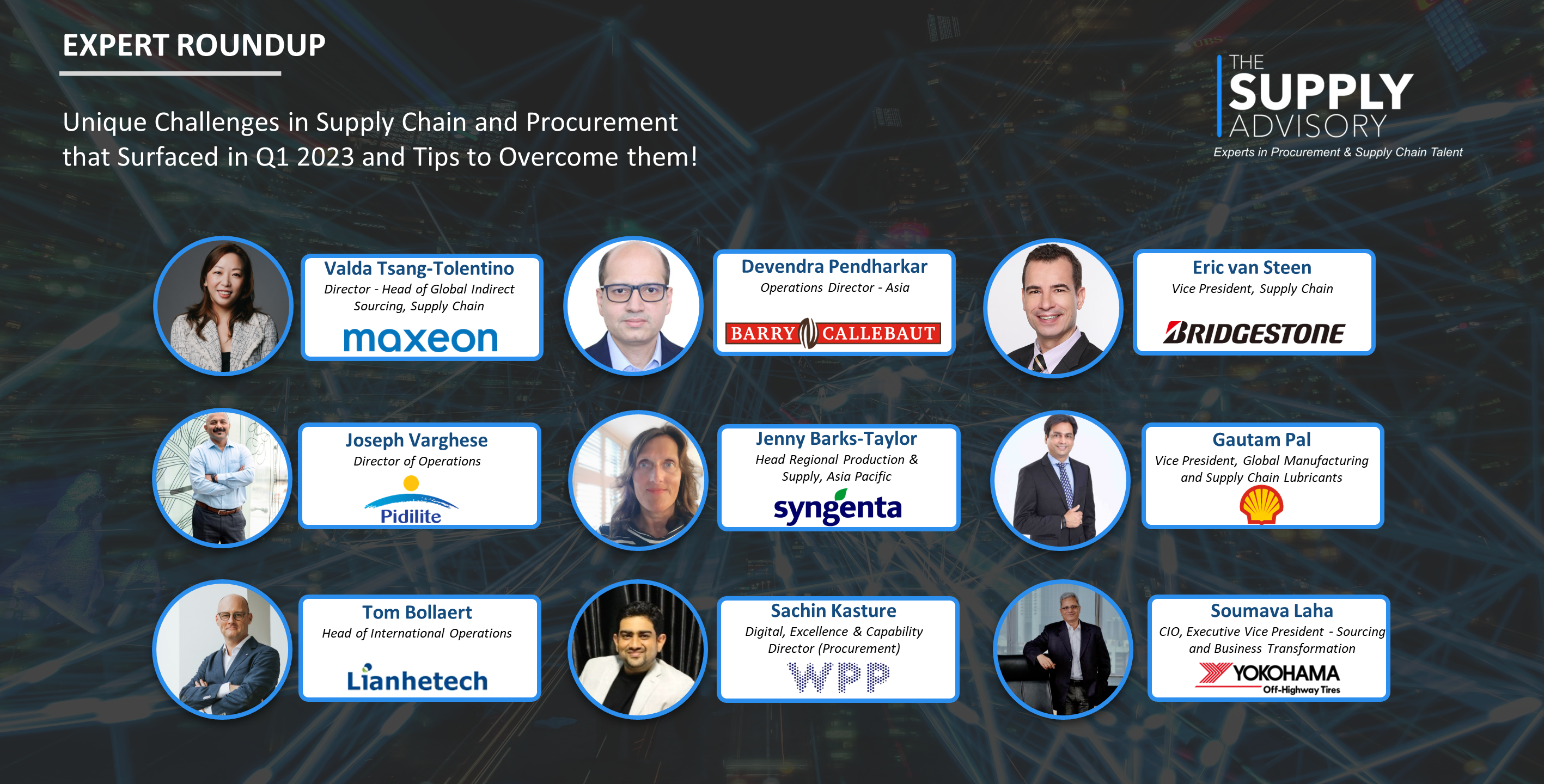
As we navigate through the year 2023, businesses are presented with a unique set of challenges. The increasing complexity of supply chain networks, rising procurement costs, and the need to balance customer and employee expectations are some of the challenges that businesses are grappling with. Not to mention the impact of geopolitical tensions, inflation, and the pandemic, businesses are seeing the need more than ever to strike a balance between efficiency and resilience, collaborate with external partners, and invest in purposeful digitalization to succeed in the current and future landscape.

In today’s environment, customers demand faster and more personalized experiences, while employees by and large expect greater flexibility and better work-life balance. Switching gears in optimizing their supply chain operations, prioritizing spend management, and balancing innovation with employee needs have been some of the areas where companies have been taking initiatives to overcome the challenges they face and support drive long-term success and growth.
To gain further insight into this crucial matter, I invited 9 distinguished Leaders in Supply Chain, Procurement, Manufacturing and Operations from a variety of industries namely Renewables, Chemicals, Automotive, Adhesives, Food and Beverage, Oil and Gas, and Advertising and asked them to share with us the:
“Unique Challenges in their business’ Supply Chain/Procurement that cropped up in Q1 2023 which they think would take further shape in the coming months as well as Tips to overcome them”.
Below is what our Expert Guests revealed.

Valda Tsang-Tolentino
Director – Head of Global Indirect Sourcing, Supply Chain
Maxeon Solar Technologies
Geo-Political Impacts are not a single event but form the continually evolving backdrop
Procurement and supply chain will need to develop strategies with optionality and multiple iterations as the default to enable business strategy to adapt and pivot. This is a must have not only to gain competitive advantage, but it could be existential for some organizations to survive.
Talent attraction and development
The most capable people will not only be those with technical skills and experience. These are simply not enough to add value and manage risk effectively. Collaboration, proactiveness in reaching beyond their own silos and ability to connect the dots strategically will be the key differentiator between mediocre and top calibre talent. Professionals who learn fast, adapt and course correct, with a bias towards progression not perfection is critical to delivering value.
Transformation alongside day-to-day delivery is the norm.
With organisational restructures and leaner teams, gone are the time where transformation was a dedicated function. Senior leadership expectation of transformation remains the same, but the reality is that it is slower and variable due to the proliferated efforts and capabilities. Team members are also over-stretched on top of strategy making and firefighting. Change management needs to be everyone’s everyday job.

Gautam Pal
Vice President, Global Manufacturing and Supply Chain Lubricants
Shell
Resiliency: Is an investment not a cost
Supply chain resiliency is a strategic approach to managing risk and disruption in the supply chain that allows businesses to anticipate, respond to, and recover from disruptions in a timely manner. By investing in supply chain resiliency, businesses can ensure they are prepared for any potential disruptions. In last 3 years, Supply Chain has witnessed multiple disruptions which can be bucketed into 3 categories – 3C’s: Covid (pandemic); Climate changes and Conflict. These disruptions will only become more rampant in future. This proactive approach can help organizations reduce business losses and minimize the impact of disruptions on their operations. Additionally, supply chain resiliency helps businesses improve their customer service, minimizes customer churn, and reduces their costs by ensuring that products are delivered on time and in the right condition. Finally, supply chain resiliency can also help businesses build trust with their customers, suppliers, and other stakeholders by demonstrating their commitment to reliability and quality. In short, supply chain resiliency is an investment that pays dividends in the long run.
Strategy in the Age of Digital Disruption
In today’s age of Digital Disruption, every company is either a Technology company or will cease to exist in the long term. Data and AI/ML have turned traditional computer programming upside down. We can leverage this technology to target consumers on an unprecedented scale, increasing the possibilities of new products and services and creating new business models in our own organizations. Every company needs to have a clear Strategy on Digital Disruption across the value chain. This strategy should encompass how digital is transforming the external landscape (environment), patterns of demand and competitive pressures that will impact your company, create a unique value canvass using Digital enablers to convert threats to opportunities and have a robust execution plan. Key ingredients for success on execution are senior leadership understanding and embracing digital disruption, investing in digital capability (Make-Buy-Borrow), empowering and having trust in the team.
Demand softening – how to wind down operation to manage cost and gain market share going forward
For CPG Industries the period 2020 ~ 2022 witnessed phenomenal demand growth (in some sectors there was demand growth >10%). However, very few companies’ volume or revenue grew mainly because of several supply challenges posed by unanticipated disruptions. As a result, most companies focused on investing in their Supply Chain becoming resilient, predictive, and cost competitive. Going forward the problem is shifting from being a supply challenge to a Demand (or lack of demand) challenge. The companies which invested in making their E2E Supply chain (Plan – Source – Make – Deliver) resilient, collaborated with Suppliers at a strategic level, streamlined their portfolio, made their business processes like Integrated Business process robust and invested on purposeful digitalization will be able to thrive in this new challenge.

Eric van Steen
Vice President, Supply Chain
Bridgestone Asia Pacific
Raw material price volatility
Although raw material prices have generally come down from their highs in the first half of 2022, we have seen more volatility in the prices in Q1 making it more challenging to forecast profitability and apply a consistent/logical market pricing strategy. Response: providing transparency (internally and externally) are the key to navigate this situation.
Labour shortages
In countries like Australia and New Zealand, it can be challenging to find people to fill key roles in operations and mobility services as there is a general shortage in the marketplace. Response: engaging prospective employees by offering interesting apprenticeship opportunities with long-term career perspectives.
Volatility in demand
In some countries, we have seen some unexpected changes in government policies or tighter controls with regards to credits from banks which have made demand forecasting more challenging. Response: continue to stay agile and flexible to adjust to the changes.

Devendra Pendharkar
Operations Director – Asia
Barry Callebaut
High inflation impacting business growth and profitability
Commodity (fuel, food) prices have drastically increased in the past few months, resulting in higher cost of materials, manufacturing and distribution elevating the risk of loss of business revenue and/or margin. In this environment, supply chains need to keep a relentless focus on driving productivity in operations via sourcing efficiency, variablizing costs and reduction in waste while concurrently working on optimizing the product portfolio towards more differentiated and margin accretive products.
Finding the right balance between efficiency and resilience for competitive advantage
During the height of the pandemic, supply chains have been in crisis management mode to get products to customers in the face of material and labour shortages, port congestions and delays. Supply chains are now expected to be both efficient and resilient. In this context, leveraging data through interconnected systems for enhanced visibility, effective decision support and interoperability/agility has gained momentum.
Extracting business value from supply chain innovations
Customers and investors are increasingly favoring companies with sustainable ESG practices. Supply chains need to collaborate not just with internal stakeholders but also with external partners (vendors, suppliers, customers, competitors, and regulators) to capture the full impact of their efforts in reducing negative impact to environment, support communities in which they operate, and drive purpose led performance by curating the right mix of in-house and external capabilities.

Jenny Barks-Taylor
Head Regional Production & Supply, Asia Pacific
Syngenta
We have seen a significant shift from supply disruption driven by many macro-economic factors over the last two years to supply availability being normalized. This has very quickly turned into inventory and cost management being the two important supply chain dimensions to excel in. To any supply chain professional, these are not new. However, the speed of the change has been surprising, and this requires a mindset shift from ‘supplying at any cost’ to being prepared to take more risk in supply chains in order to manage inventory and cost. The Sales & Operations Planning process once again becomes critical to create cross-functional business forums to make the tradeoff decisions which are right for the business.
We have seen an acceleration in the development and application of digital as a result of the COVID-19 pandemic. However, in the Agricultural Industry, particularly in APAC, the use of digital and data to enable food security and sustainable agriculture is still relatively embryonic. We are seeing a significant increase in the number of startup companies in Agriculture as investors seek to create value. Winners in the industry will be those who work out how to leverage and create value from the use of digital advanced technologies and data created on the farm and through the connectivity with the farmer and channel partners back into the supply chain ecosystem.
Diversity and Inclusion remains a key challenge for females in the Agriculture Industry and in certain key roles. Working systematically to remove physical barriers and unconscious bias remains an important challenge to overcome in order to increase diverse workforces, particularly in manufacturing and commercial roles. This can be in simple areas, such as ensuing right sizing of personal protective equipment or ensuring personal safety through careful allocation of sales areas.

Soumava Laha
CIO, Executive Vice President – Sourcing and Business Transformation
Yokohama Off-Highway Tires
Geopolitical Escalation (Hot War, Trade War, Cyberattacks)
Amidst the looming threat associated with deglobalization and regionalization/localization of supply chains, following the pandemic and Russia’s invasion of Ukraine coupled with the relationship between the top two super powers at an all-time low, supply chains across industries have accelerated the process of de-risking their supply chains through multi sourcing, manufacturing network diversification, building eco system partnerships, platform-product/plant harmonization, building redundancy in their end to end supply chain network.
Stubborn Inflation/Central Bank Monetary Tightening/Energy Market Shocks
The price tension from rising commodities and lack of supply was a dominating factor for most of last year. Market stability is still a factor especially in commodities affected by Russia-Ukraine war (namely oils and metals). In a recessionary market, it’s important for companies to manage inventories closely through the shifts. Today, an average warehouse is saddled with the wrong inventory (with higher carrying cost from inflationary times). In the slowing economy, companies will shy away from declaring the write offs needed to free up warehouse capacity, but will miss the price opportunities of managing demand in volatile economic environment.
Demand – Supply Variability/Shocks
As the markets slow and recessionary pressures evolve, buying patterns will shift. The story will not be of demand decline but a perceptible change in demand mix. The issues of supply will continue as companies sort through the issues with the pandemic, Russia-Ukraine war, and food insecurity in low-income countries.

Tom Bollaert
Head of International Operations
Lianhe Chemical Technology
The Energy costs went up drastically in 2022, driven by high gas prices as a consequence of the Russia-Ukraine war. They came down again in 2023, but the uncertainty remains. Relatively speaking gas prices peaked higher versus electricity in Europe, as more electricity was generated from alternative sources such as wind and nuclear. As the uncertainty remains, careful hedging strategies for gas and electricity will be a key component, in addition to driving more aggressive energy saving projects and considering alternative energy sources.
There are currently many geopolitical dynamics at play introducing additional risk. Diversifying the supply sources and manufacturing network will be critical to mitigate potential risks. Currently, many production comes from China and India. We could look at diversifying to Southeast Asia and also sources in Europe and US for high value adding products. Southeast Asia, in particular Malaysia, is currently attracting a lot of new investments.
The pandemic had a big impact on the availability and the delivery time of engineering equipment and parts. This situation is still not resolved and much higher lead-times versus pre-pandemic continue to exist. A good understanding of what is your critical equipment and spare parts is essential to anticipate. Best practices in maintenance driven by increasing predictive approaches to avoid breakdown is key.

Sachin Kasture
Digital, Excellence & Capability Director (Procurement)
WPP
Digital Procurement Transformation – When Solution Is a Problem Statement
We don’t need to reiterate why digital transformation is an absolute must for Procurement. However, if you google “the modern procurement platform stack”, you will find multiple images showing hundreds, if not thousands, digital solutions available in the market. Companies end up juggling with “Best-In-Class” Vs “One-Average-Solution-for-All”, add the tight budget & implementation cost on top of it. It’s high time now to have some consolidations in the digital procurement world.
High Margin Industries
Typically, companies with a higher profit margin (e.g., service, IT) tend to have more focus on top-line than bottom-line. While it makes perfect sense to focus on sales & growth, you will find a lesser procurement maturity in such organisations, as compared to low margin industries (e.g., FMCG). With the overall mature indirect & direct procurement landscape, things have rapidly improved in this area.
Attraction of right procurement talent across all industries
Contrary to the fact that procurement is one of the industry diagnostic functions, companies have seen varying levels of talent attracted to the procurement function. The onus lies on procurement leaders to express more about the great work they are doing which will inspire the next generation of talent to attract in the procurement function.

Joseph Varghese
Director of Operations
Pidilite
Impact of High Inflation Rate
The year kicked off with economies battling new records of inflation rate and worries of global recession caused by continuing geopolitical conflicts and myriad of other reasons. The price of fuel and energy skyrocketed in the quarter, impacting overall manufacturing and distribution costs and hence affecting profit margins. As various nations wait for monetary policies which take effect to cool inflation levels, costs are predicted to remain high. To navigate supply chain through such economic headwinds, diversifying supply networks through contingency plans, alternate logistic networks, multiple supplier strategy can develop flexibility and strategically reduce costs. Managing the Supply chain finance effectively optimises working capital for suppliers and buyers to improve supply chain health.
Keeping Pace with Technology
Digital transformation of supply chains has observed an upsurge since the pandemic and has led to the application of technologies such as Artificial Intelligence (AI), Machine Learning (ML), Digital Twins and Blockchain in Supply Chain Management. The number of tech-focused supply chain startups in Asia alone has dramatically increased in the last year. While technologies continue to advance rapidly, it has become challenging to keep pace with the latest developments. As supply chain professionals, it is imperative to understand and align strategies to embrace technologies to stay competitive while reinventing within the organisation.
People capability & Talent retention in Supply Chain
The evolving technology in Supply chain has unsettled employees to seek more attractive positions and industries. Competition for skilled and experienced talent is increasing and therefore, retaining the right talent is crucial to business success and improvement. Now more than ever, it is important to proactively invest in people and address issues of skill gaps, upskilling aligned to the changing technologies. As best practice, fostering transparency in relationships with employees is critical to creating an environment of trust and inclusion.
I hope that our expert roundup has shed light on overcoming challenges that resonate with you/your industry/business. Our team at The Supply Advisory would like to express our appreciation to the contributors for taking the time to share their perspectives on this subject. Thank you very much!
Stay tuned to The Supply Advisory Blog for more expert opinions and engaging conversations on various Supply Chain Management themes.

Ananya Sinha Roy is the Director at The Supply Advisory, a leading executive recruitment firm specialising in Procurement & Supply Chain.
You can view the The Supply Advisory website or contact them directly at info@supplyadvisory.com for a more detailed discussion.